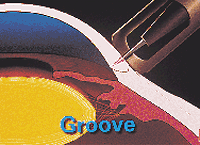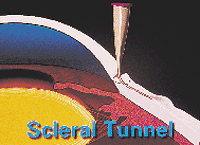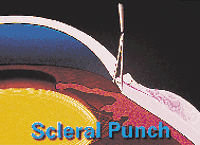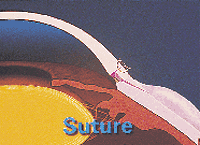Combined reverse procedure appears tissue-friendly, safe
However, 2-year outcomes are somewhat disappointing because of scarring, surgeon says.
WAILEA, U.S.A. — A combined reverse hinge trabeculectomy/cataract extraction might be promising, despite somewhat disappointing outcomes at 2 years.
“You can use the same groove that you make for the hinge incision when removing a cataract, so the combined procedure doesn’t require two separate locations,” said David W. Langerman, MD, a glaucoma, cataract and cornea specialist in group private practice in Orangeburg, N.Y. In addition, “the combined procedure is fast and tissue-friendly. In other words, it doesn’t traumatize the tissues the way a standard trabeculectomy does.”
Dr. Langerman, who spoke at the Hawaii 2000 meeting sponsored by Ocular Surgery News and The New England Eye Center, has performed the reverse hinge trabeculectomy for the past 2 years. “I wanted to avoid bleb formation and achieve a more posterior flow into sub-Tenon’s space,” he said. “In removing the cataract, we make a corneal tunnel that goes in the anterior direction, but for the trabeculectomy, we make a scleral tunnel going in the reverse direction. This is why we call it a reverse hinge.”
More specifically, the relatively simple procedure begins with a side port created by a super blade, and 0.25 cc of nonpreserved Xylocaine (lidocaine HCl, AstraZeneca LP) is instilled into the anterior chamber. “A small amount of viscoelastic also is instilled into the anterior chamber,” Dr. Langerman said. The hinge template is then set down anteriorly to the conjunctival arcade. A diamond knife, set at 500 µm, is used to make a groove into clear cornea.
Spoon-shaped steel blade
“I make a scleral tunnel by using a spoon-shaped steel blade because steel gives you much better control,” Dr. Langerman said. “The blade enters at the base of the groove, travels in an upward direction, and exits through the sclera into sub-Tenon’s space,” resulting in a scleral tunnel 5 mm long. A spongy wick, dipped in mitomycin, is then guided through the scleral tunnel and into sub-Tenon’s space. “After 3 minutes, the sponge is removed and sub-Tenon’s space is irrigated copiously with balanced salt solution,” Dr. Langerman said.
“Attention is now turned to removing the cataract,” he continued. A 2.75-mm keratome enters the corneal stroma at one-third the stromal depth, follows the corneal curvature for 2 mm, and enters the anterior chamber. Capsulorrhexis, hydrodissection and phacoemulsification are performed, with a foldable IOL placed in the capsular bag.
“The hinge, or base of the groove, is incised in order to communicate with the anterior chamber,” Dr. Langerman said. The anterior scleral floor is excised with Vannas scissors or a special punch that Dr. Langerman and his colleagues have designed. “When the punch engages the anterior scleral floor, the tip of the punch moves the ciliary processes in a posterior direction. In other words, it pushes the ciliary body away from the jaws of the punch and out of harm’s way,” Dr. Langerman said. “Although using the punch saves time, more importantly it makes the operation safer.” A peripheral iridectomy is made superiorly, and finally the wound is closed with one or two nylon sutures.
Study results discouraging
Despite Dr. Langerman’s enthusiasm for reverse hinge trabeculectomy, 2-year outcomes are somewhat disappointing. “Although first-year results were quite encouraging, that did not continue into the second year because of fibrosis, which caused the filtration channels to scar down, even though I used mitomycin,” he said.
There were 18 patients enrolled in the first year of the study. “The mean preoperative pressure in the first year was 21 mm Hg,” Dr. Langerman said. Postoperatively, the IOP dropped to 15 mm Hg, which was a 22% reduction. “The percentage of patients below 18 mm Hg who did not require medications was 78%. And the number of medications required was only one,” Dr. Langerman said.
The number of patients for the second year was reduced to 14 because of dropout. “At the end of the second year, only 47% of patients below 18 mm Hg were able to function without medications,” Dr. Langerman said. Nonetheless, “it is a very elegant procedure. I believe it can still work if we can prevent the filtration channels from scarring down.” Dr. Langerman hopes to make the reverse hinge trabeculectomy sutureless and avoid mitomycin. In summary, he said, “this procedure is so tissue-friendly and so elegant that it deserves further research and development to make it work better.”
 A diamond knife, set at 500 µm, is used to make a groove into clear cornea. |
 Dr. Langerman makes a scleral tunnel by using a spoon-shaped steel blade because he said, “steel gives you much better control.” |
 The anterior scleral floor is removed with a special punch or Vannas scissors. |
 A 10-0 nylon suture is used to close the wound. |
For Your Information:
- David W. Langerman, MD, can be reached at 99 Dutch Hill Road, Orangeburg, NY 10962 U.S.A.; +(1) 914-359-7272; fax: +(1) 914-359-1508; e-mail: leicares@aol.com. Dr. Langerman has no direct financial interest in any of the products mentioned in this article, nor is he a paid consultant for any companies mentioned.
